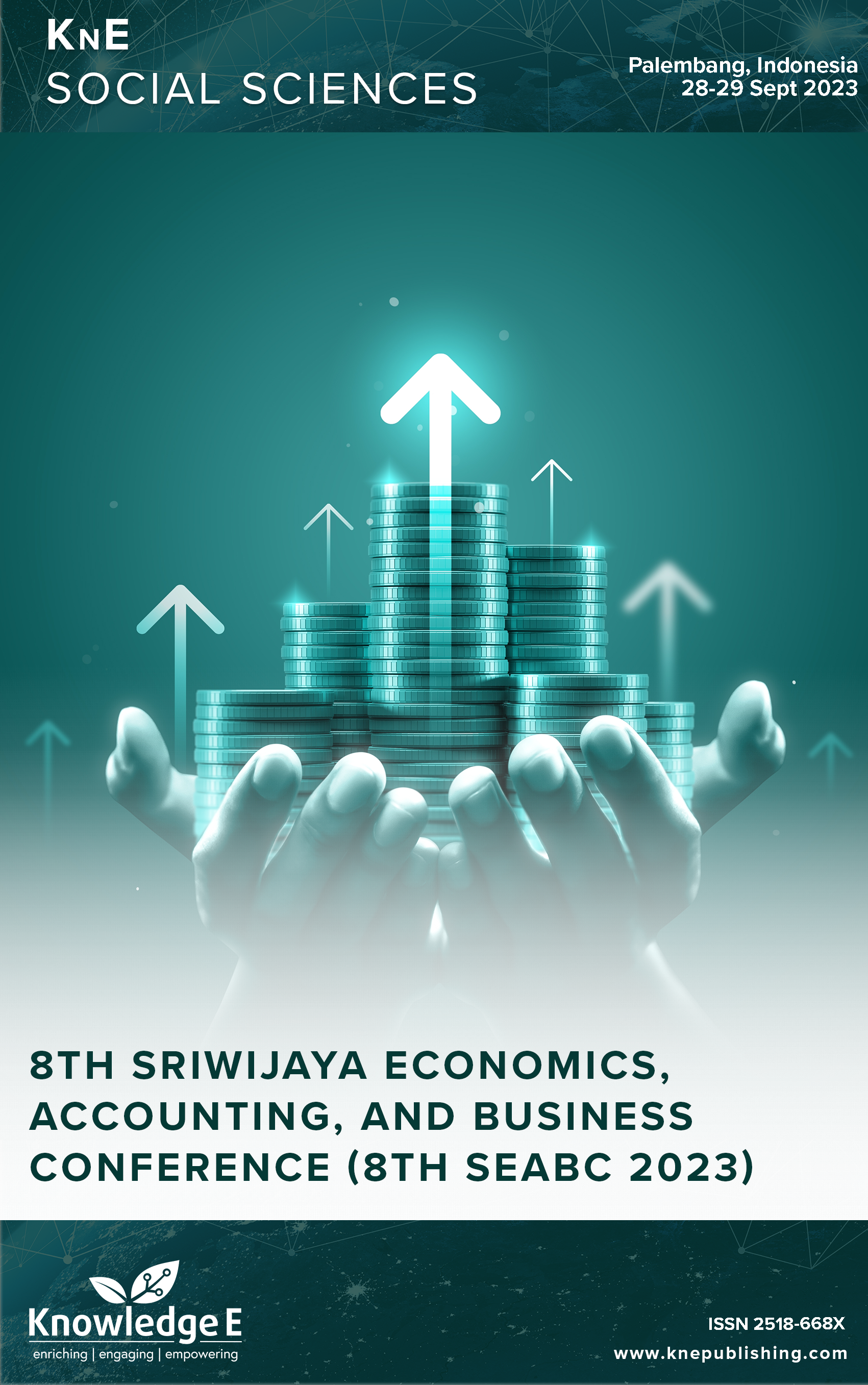Factors Influencing Tangerang City MSMEs' Financial Literacy
DOI:
https://doi.org/10.18502/kss.v9i14.16099Abstract
Financial literacy is the knowledge about financial product and services. It is also defined as financial management skills that one should have in order to reach financial welfare, especially for Micro, Small, and Medium Enterprises. The purpose of this study is to analyze the effects of income, educational level, gender, age, and length of business on the financial literacy level of MSMEs in Tangerang City. This study used quantitative methods and used Proportionate Stratified Random Sampling as the sampling technique with 100 MSMEs as a sample. It was conducted in 11 subdistricts in Tangerang City – Tangerang, Batuceper, Larangan, Karawaci, Cibodas, Cipondoh, Pinang, Ciledug, Karang Tengah, Neglasari, and Periuk. The study used Multiple Linear Regression as an analysis technique. Based on the analysis carried out using the SPSS application, the results showed that: (i) the financial literacy index of MSMEs in Tangerang City was an average of 76.15%; (ii) income has a positive and significant influence on financial literacy level on MSMEs in Tangerang City; (iii) education level has a positive and significant influence on the financial literacy level; (iv) gender has no significant influence on the financial literacy level; (v) age has a positive and significant influence on the financial literacy level; and (vi) the length of business has a positive and significant influence on financial literacy level. The implication of this study are: MSMEs can increase their financial literacy level by making monthly financial records using digital technology and increase their ability to adapt with financial technology. Cooperatives and Small and Medium Enterprise Office can conduct more financial literacy workshop and increase MSMEs’ access to technology and financial product and services in order to increase financial literacy level of MSMEs in Tangerang city so that MSMEs can reach financial welfare.
Keywords: MSMEs, financial literacy, income, educational level, gender, age, and the length of business
References
Consumer Financial Protection Bureau. Consumer-driven definition of personal financial well-being. 2015;3.
Atkinson A, Messy FA. Measuring financial literacy: Results of the OECD / INFE Pilot Study. J Consum Aff. 2012;15(15):1–73.
BI. Peningkatan Akses Jasa Keuangan Pada Kelompok Masyarakat Pesisir Sektor Perikanan Tangkap. Publ Bank Indonesia. 2017;72.
OJK. Strategi Nasional Literasi Keuangan Indonesia. 2021.
OJK. Hasil Survei Literasi Keuangan dan Inklusi Keuangan. 2020.
BCA. MSMEs: Definitions, types and criteria. https://www.bca.co.id/en/informasi/ Edukatips/2022/02/10/03/15/kenali-pengertian-umkm-jenis-dan-kriteria-bisnis-didalamnya
Tangerang BK. Kota Tangerang Dalam Angka Badan Pusat Statistik Kota Tangerang Bps-Statistics of Tangerang Municipality. Consultative Group to Assist the Poor. 2021.
Lusardi A. Financial literacy and the need for financial education: Evidence and implications. Swiss J Econ Stat. 2019;155(1):1–8. DOI: https://doi.org/10.1186/s41937-019-0027-5
Consultative Group To Assist The Poor. Financial Inclusion. https://www.cgap.org/financial-inclusion; 2011.
Soetiono KS, Setiawan C. Literasi Dan Inklusi Keuangan Indonesia. Rajawali Pers; 2018.
Boediono. Pengantar Ilmu Ekonomi Makro. 2018.
Manurung. Ekonomi Keuangan dan Kebijakan Moneter. Jakarta: Salemba Empat; 2009.
Samuelson PA, Nordhaus WD. Nineteenth Edition. 2009;26. DOI: https://doi.org/10.1111/j.1540-5842.2009.01070.x
Paita S, Tewal B, Sendow GM. Jurnal Emba. Pengaruh Kompensasi Dan Lingkungan Kerja Terhadap Kinerja Pegawai Melalui Motivasi Kerja Pada Balai Pendidik Dan Pelatih Keagamaan Manad. 2015;3:683–694.
Mankiw. Macroeconomics. 9th ed. New York: Worth Publishers; 2016.
Rasmini M, Suryanto S. Tinjauan Aplikasi Sistem Informasi Akuntansi. Jurnal Ilmu Politik dan Komunikasi. 8. Epub ahead of print 2018. https://doi.org/10.34010/jipsi.v8i2.1334 DOI: https://doi.org/10.34010/jipsi.v8i2.1334
Baiq Fitri Arianti, Khoirunnisa Azzahra. Faktor - Faktor Yang Mempengaruhi Literasi Keuangan : Studi Kasus UMKM Kota Tangerang Selatan. Jurnal Manajemen dan Keuangan. 2020;9:156–171.https://doi.org/10.33059/jmk.v9i2.2635 DOI: https://doi.org/10.33059/jmk.v9i2.2635
Soraya E, Lutfiati A. Analisis Faktor-Faktor Yang Mempengaruhi Literasi Keuangan. Kinerja. 2020;2(2):111–134. DOI: https://doi.org/10.34005/kinerja.v3i01.966
Lestari MD, Kantun S, Hartanto W, Suharso P, Widodo J. Analysis of the financial literacy level of micro, small and medium enterprises (MSMEs). In Jember, East Java, Indonesia. IOP Conf Ser Earth Environ Sci. 2020;485(1):012128. Https://Doi.Org/10.1088/1755-1315/485/1/012128 DOI: https://doi.org/10.1088/1755-1315/485/1/012128
Bharucha JP. Socio-economic and demographic determinants of indian youth financial literacy: Determinants of financial literacy. Int J Asian Bus Inf Manage. 2017;8(4):15–28. DOI: https://doi.org/10.4018/IJABIM.2017100102
Lusardi A, Mitchell OS. Financial literacy around the world: An overview. J Pension Econ Finance. 2011;10(4):497–508. DOI: https://doi.org/10.1017/S1474747211000448
Florence School Of Banking And Finance. Gender differences in financial literacy. 2021. https://fbf.eui.eu/gender-differences-in-financial-literacy/
Aziz MA. Pengaruh Faktor Usia, Tingkat Pendidikan Dan Lama Usaha Terhadap Literasi Keuangan (Studi Kasus Pada Pelaku UMKM di Kota Malang). Angew Chem Int Ed. 2021;6(11):1–8.
Bill F, Pembinaan Untuk Meningkatkan Kinerja Karyawan RS. Jakarta; 2001.
Potrich AC, Vieira KM, Kirch G. Determinants of financial literacy: Analysis of the influence of socioeconomic and demographic variables. Rev Crontab E Finance. 2015;26(69):362–377. DOI: https://doi.org/10.1590/1808-057x201501040
Guzman F, Paswan A, Tripathy N. Consumer centric antecedents to personal financial planning. J Consum Mark. 2019;36(6):858–868. DOI: https://doi.org/10.1108/JCM-01-2018-2514
Ghozali I. Aplikasi Analisis Multivariate Dengan Program Ibm Spss 25 Edisi Ke- 9, http://slims.umn.ac.id//index.php?p=show_detail&id=19545 (2018, accessed 22 April 2022).
Gujarati DN. Dasar-Dasar Ekonometrika Edisi Ketiga (Edisi Ketiga). Erlangga; 2007.
Ningsih S, Dukalang HH. Penerapan Metode Suksesif Interval pada Analisis Regresi Linier Berganda. Jambura J Math. 2019;1(1):43–53. DOI: https://doi.org/10.34312/jjom.v1i1.1742
Anshika SA, Mallik G. Determinants of financial literacy: Empirical evidence from micro and small enterprises in India. Asia Pacific Management Review. 2021;26(4):248–255. DOI: https://doi.org/10.1016/j.apmrv.2021.03.001
Sucuahi WT. Determinants of financial literacy of micro entrepreneurs in Davao City. International Journal Of Accounting Research. 2013;1(1):44–51. DOI: https://doi.org/10.12816/0001127
Di K, Umkm K, Tegal K. Analisis Faktor Yang Mempengaruhi Tingkat Literasi Keuangan Di Kalangan Umkm Kota Tegal. Manga Anal J. 2015;4:252–257.
Fuady MR. Pengaruh Faktor Demografi Terhadap Literasi Keuangan Syariah Masyarakat Kecamatan Candi Laras Selatan Kabupaten Tapin. 2021.

